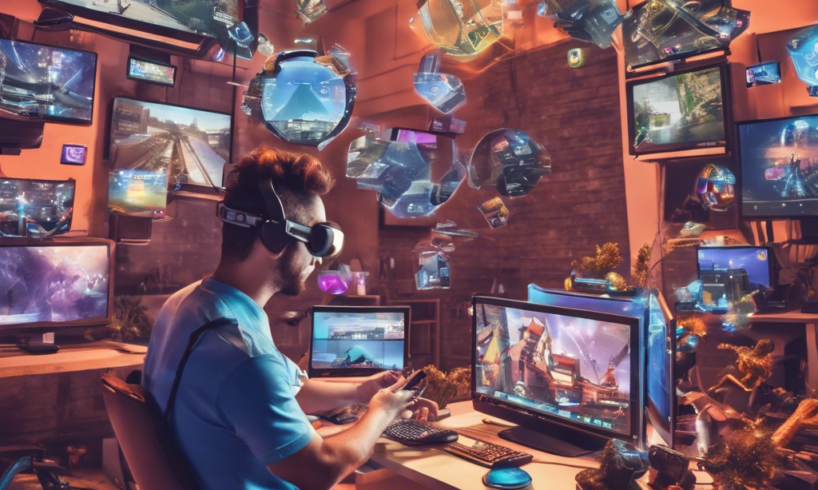
The gaming industry has always been at the forefront of technological innovation, constantly evolving to create more immersive and interactive experiences for players. One of the most exciting developments in recent years is the integration of Augmented Reality (AR) into video games. This article explores the world of AR in gaming, delving into its definition, its rise in popularity, historical milestones, iconic modern examples, and what the future holds for this groundbreaking technology.
What is Augmented Reality in Gaming?
Augmented Reality (AR) in gaming refers to integrating digital information with the player's environment in real-time, creating an interactive experience that blends the virtual world with the physical one. Unlike Virtual Reality (VR), which immerses players in a wholly digital environment, AR overlays computer-generated elements onto the real world, enhancing it rather than replacing it. This technology utilizes smartphones, tablets, and AR glasses to superimpose visuals, sounds, and other sensory enhancements onto the user's surroundings.
In AR gaming, players can interact with physical and virtual objects simultaneously. For example, a game might project a digital character onto a real-world table, allowing players to engage with the character as though it were physically present. This creates a more immersive and engaging experience compared to traditional gaming. AR games often leverage the built-in cameras and sensors of mobile devices to track the player's movements and surroundings, ensuring that the digital elements align accurately with the real world.
The potential for AR in gaming is vast. It offers new ways to engage players and create unique experiences that are impossible with traditional or VR games. From location-based adventures to interactive storytelling, AR is expanding the boundaries of how we perceive and interact with video games.
The Rise of AR: Popular Video Games Utilizing Augmented Reality
The rise of augmented reality (AR) in video games has transformed how players interact with digital content, seamlessly blending the virtual and real worlds. One of the most notable examples is Pokémon GO, developed by Niantic, which took the world by storm in 2016. This game lets players capture Pokémon superimposed on real-world locations using their smartphones, creating an engaging and interactive experience that encourages physical exploration.
Another significant title in the AR gaming landscape is “Harry Potter: Wizards Unite,” also developed by Niantic. This game extends the AR experience into the wizarding world, where players can discover magical artifacts, encounter iconic characters, and engage in spell-casting battles in real-world environments.
Moreover, “Minecraft Earth” by Mojang Studios brings the beloved block-building game into augmented reality, allowing players to build structures and collaborate with others in their neighborhoods. This innovation enhances creativity and fosters social interaction within a shared AR space.
These popular AR games have set a precedent for future developments, showcasing the potential of augmented reality to create immersive, interactive experiences that transcend traditional gaming boundaries. As technology continues to evolve, the integration of AR in video games is expected to expand, offering even more captivating and dynamic gameplay opportunities.
A Historical Perspective: The First AR-Based Video Game
The first augmented reality (AR)- based video game can be traced back to 2000 when Bruce Thomas and his team at the University of South Australia Wearable Computer Lab developed ARQuake. ARQuake was an adaptation of the popular first-person shooter game Quake, but with a revolutionary twist: it integrated real-world environments into its gameplay.
Players of ARQuake wore a head-mounted display (HMD) that superimposed virtual elements onto their view of the real world. This required them to move around physically in their environment, blending digital monsters and objects seamlessly with their actual surroundings. The game used GPS and a digital compass to track the player's movements and orientation, making it one of the first instances where physical space became an integral part of gaming.
The development of ARQuake was groundbreaking as it demonstrated the potential for immersive experiences beyond traditional screen-based interactions. It laid the foundation for future innovations in AR gaming by showing how technology could bridge the gap between virtual and physical worlds. While primitive by today's standards, ARQuake's pioneering efforts set the stage for the advanced AR games we enjoy today, such as Pokémon GO and Minecraft Earth.
Iconic Examples of Augmented Reality in Modern Video Games
Several modern video games have successfully integrated augmented reality (AR) to enhance the gaming experience, creating immersive and interactive environments that captivate players. One of the most iconic examples is Pokémon GO, developed by Niantic. This game revolutionized mobile gaming by allowing players to catch virtual Pokémon in real-world locations. The game uses GPS and AR technology to place Pokémon in various environments, encouraging physical exploration and social interaction.
Another notable example is “Harry Potter: Wizards Unite,” developed by Niantic. This game invites players into the magical world of Harry Potter, where they can cast spells, discover magical artifacts, and interact with iconic characters from the series. Using AR, players see magical elements overlaid in their real-world surroundings, blending fiction with reality.
“Minecraft Earth” is another groundbreaking AR game that allows players to build structures and explore a blocky world overlaid on their natural environment. Developed by Mojang Studios, this game leverages AR to transform everyday settings into expansive Minecraft landscapes, fostering creativity and collaboration among players.
These games exemplify how AR can transform traditional gaming experiences by merging virtual elements with the physical world, offering players unique and engaging ways to interact with their favorite franchises.
The Future of Augmented Reality in the Gaming Industry
The future of augmented reality (AR) in the gaming industry is poised for remarkable advancements, driven by ongoing technological innovations and increasing consumer interest. One significant trend is the integration of AR with other emerging technologies, such as artificial intelligence (AI) and machine learning. This synergy will enable more dynamic and responsive game environments, where characters and objects can interact with players in real time, creating a more immersive experience.
Furthermore, advancements in hardware, including more sophisticated AR glasses and headsets, will likely enhance the visual fidelity and comfort of AR gaming. Companies like Apple, Google, and Microsoft are investing heavily in developing next-generation AR devices that promise to bring high-definition visuals and seamless integration into everyday life.
Cloud computing is another area that will play a pivotal role in the evolution of AR gaming. By offloading complex computations to cloud servers, AR games can deliver more complicated and expansive virtual worlds without being limited by the processing power of local devices.
The proliferation of 5G technology will enable faster data transmission speeds and lower latency, crucial for real-time AR experiences. This will allow for more interactive multiplayer AR games, where players worldwide can seamlessly engage in shared virtual spaces. The future of augmented reality in the gaming industry looks incredibly promising, with technological advancements set to create richer, more immersive, and interactive gaming experiences.
Augmented Reality has undeniably transformed the landscape of video gaming, offering new dimensions of interactivity and immersion that were previously unimaginable. From pioneering efforts like ARQuake to global sensations such as Pokémon GO and Minecraft Earth, AR has proven its potential to revolutionize how we play and experience games. As technology continues to advance, the future of AR in gaming promises even more innovative and captivating experiences, blending the virtual and physical worlds in ways that will continue to push the boundaries of our imagination.

George Smith, with over a decade in tech journalism, excels in breaking down emerging tech trends. His work, spanning tech blogs and print, combines in-depth analysis with clarity, appealing to a wide readership. George's pieces often explore technology's societal impact, showcasing his foresight in industry trends.







